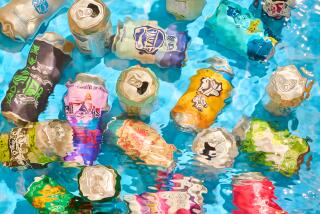How We Made It: Greg Koch and Steve Wagner
The gig: Greg Koch, 48, and Steve Wagner, 54, are the founders of Stone Brewing Co., one of the largest brewers of craft beer in the United States. The company is best known for its hoppy, high-alcohol beers, including Stone IPA, Stone Ruination IPA and Arrogant Bastard Ale.
Koch and Wagner started experimenting with home brews in Koch’s Solana Beach, Calif., condominium in the early 1990s and opened a brewery in a San Marcos, Calif., warehouse in 1996. Stone has grown from 400 barrels that year to 177,200 barrels last year, developing a cult-like following among craft beer enthusiasts.
Now headquartered nearby in Escondido, the company offers daily tours of its sprawling facility and operates a store, a tasting room and a popular restaurant. It recently opened a store in Pasadena.
Stone, a private company with 556 employees, sells many of its beers in 22-ounce bottles priced from $3.99 to $5.99. Some specialty blends cost much more. Six-packs of its top-selling beer, Stone IPA, in 12-ounce bottles retail for as much as $10.49.
The partners wouldn’t provide any financial figures but said Stone has averaged growth of about 40% in each of the last 15 years.
A chance meeting: In the early 1990s, Koch and Wagner met at a one-day UC Davis extension course about beer. They recognized each other because Wagner had played in a rock band that rehearsed at a studio Koch owned.
They talked about their mutual fondness for craft-brewed beer, and as Wagner said, a seed was “definitely planted.” Wagner took a job at Pyramid Breweries in Washington state in 1994 to learn craft brewing. He and Koch kept in touch and eventually decided to open a brewery.
Getting started: An angel investor coughed up $500,000, which they used to buy a 30-barrel brewing system and get the business started. The visionary who saw the value in an idea by a couple of dreamers? “It’s one word — D-a-d,” Koch said.
Tough sell: Once Wagner perfected the recipe for the partners’ first commercial beer, Stone Pale Ale, it was Koch’s job to sell it. So off he went, bar to bar, offering free samples from a hand-carried mini-keg.
“Most of them wrinkled their nose and said, ‘No thanks,’” Koch recalled.
Powerful and bitter, the brew was ahead of its time. It arrived years before hoppy, bitter India pale ales, or IPAs, became popular.
Red ink: In the early days, the partners said they were losing about $30,000 a month. “It felt like you ate a bowl of ice cream and then someone punched you in the stomach as hard as they could,” Koch said. They simply weren’t selling enough beer to break even. It meant another trip to Dad. “In order not to lose the money you’ve invested so far, you have to give us some more,” Koch said he told him. And Dad came through again.
Quick turnaround: “The low point was February 1998. It was just really seeming like we weren’t going to be able to get there,” Koch said. “Then March 1998 was our first profitable month.”
What happened? “The sun came out,” he said. When the weather improved, people started drinking more beer.
Eventually, beer drinkers embraced Stone’s strong, bitter, full-bodied flavors. Those qualities, Koch said, were one reason they succeeded.
Distribution woes: In the early years, Stone could not find a beer distributor to carry its brand. So the brewers bought a van and distributed it themselves. They still use their own trucks and drivers to haul their beers to markets and bars in Southern California. A national distributor handles the rest.
Stone also distributes several smaller craft beers whose brewers are having the same problems it once did.
Promoting craft beers: The company pours competing craft beers at its restaurant. Helping other brewers may seem counterproductive, but not to Stone’s founders. The idea, Koch said, is to build interest in flavorful, craft-brewed beer and steal customers from large breweries that hold a majority of market share.
“I think it’s a good business decision, because collectively we’re driving a wedge into the perception that beer is nothing more than fizzy yellow stuff,” Koch said.
Two leaders: “We definitely butt heads and argue about things,” Wagner said. “We do disagree, and we end up in a place we can agree on. That’s one of the things that’s kept us from making a big mistake.”
They agree, though, that they don’t want to go public or sell out. “That’s the path into becoming one of those companies we don’t want to be,” Wagner said.
Advice: “Be true to yourself. Ignore everybody. Do it the way you think it should be done,” Koch said. “Most people do it the way that, maybe, somebody else thinks it should be done.”
Wagner put it this way: “It’s the willingness to take risks, never being satisfied. There’s always something you can do better.”
What’s at home: Koch has several craft beers from a trip to Brazil in his home refrigerator. Wagner has Stone Enjoy By 04.01.13 IPA and a beer he designed in collaboration with local brewers Green Flash and Pizza Port Carlsbad called Highway 78 Scotch Ale.
At home: Koch, who is not married, still lives in Solana Beach. Wagner lives in Poway, Calif., with his wife, Laura, and their two children.
More to Read
Inside the business of entertainment
The Wide Shot brings you news, analysis and insights on everything from streaming wars to production — and what it all means for the future.
You may occasionally receive promotional content from the Los Angeles Times.











